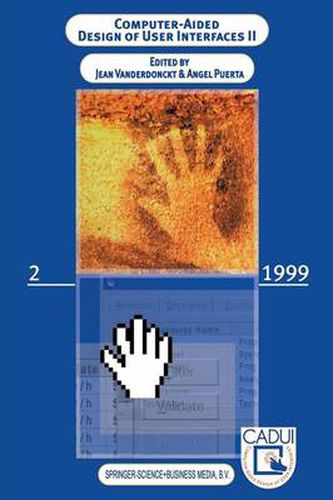Readings Newsletter
Become a Readings Member to make your shopping experience even easier.
Sign in or sign up for free!
You’re not far away from qualifying for FREE standard shipping within Australia
You’ve qualified for FREE standard shipping within Australia
The cart is loading…






This title is printed to order. This book may have been self-published. If so, we cannot guarantee the quality of the content. In the main most books will have gone through the editing process however some may not. We therefore suggest that you be aware of this before ordering this book. If in doubt check either the author or publisher’s details as we are unable to accept any returns unless they are faulty. Please contact us if you have any questions.
INTRODUCTION TO COMPUTER-AIDED DESIGN OF USER INTERFACES l 2 Jean Vanderdonckt and Angel Puerta ,3 Jlnstitut d'Administration et de Gestion - Universite catholique de Louvain Place des Doyens, 1 - B-1348 Louvain-la-Neuve (Belgium) vanderdonckt@gant,ucl. ac,be , vanderdoncktj@acm,org Web: http://www. arpuerta. com JKnowledge Systems Laboratory, Stanford University, MSOB x215 Stanford, CA 94305-5479, USA puena@camis. stanford. edu 3RedWhaie Corp. , 277 Town & Country Village Palo Alto, CA 94303, USA puerta@ redwhale. com Web: http://www. redwhale. com Computer-Aided Design of Vser Interfaces (CADUI) is hereby referred to as the particular area of Human-Computer Interaction (HCI) intended to provide software support for any activity involved in the development life cycle of an interactive application, Such activities namely include task analysis, contextual inquiry [l], requirements definition, user-centred design, application modelling, conceptual design, prototyping, programming, in- stallation, test, evaluation, maintenance, Although very recently addressed (e. g. , [3]), the activity of re-designing an existing user interface (VI) for an interactive application and the activity of re-engineering a VI to rebuild its underlying models are also considered in CADVI. A fundamental aim of CADVI is not only to provide some software sup- port to the above activities, but also to incorporate strong and solid meth- odological aspects into the development, thus fostering abstraction reflection and leaving ad hoc development aside [5,7]. Incorporating such methodo- logical aspects inevitably covers three related, sometimes intertwined, facets: models, method and tools.
$9.00 standard shipping within Australia
FREE standard shipping within Australia for orders over $100.00
Express & International shipping calculated at checkout
This title is printed to order. This book may have been self-published. If so, we cannot guarantee the quality of the content. In the main most books will have gone through the editing process however some may not. We therefore suggest that you be aware of this before ordering this book. If in doubt check either the author or publisher’s details as we are unable to accept any returns unless they are faulty. Please contact us if you have any questions.
INTRODUCTION TO COMPUTER-AIDED DESIGN OF USER INTERFACES l 2 Jean Vanderdonckt and Angel Puerta ,3 Jlnstitut d'Administration et de Gestion - Universite catholique de Louvain Place des Doyens, 1 - B-1348 Louvain-la-Neuve (Belgium) vanderdonckt@gant,ucl. ac,be , vanderdoncktj@acm,org Web: http://www. arpuerta. com JKnowledge Systems Laboratory, Stanford University, MSOB x215 Stanford, CA 94305-5479, USA puena@camis. stanford. edu 3RedWhaie Corp. , 277 Town & Country Village Palo Alto, CA 94303, USA puerta@ redwhale. com Web: http://www. redwhale. com Computer-Aided Design of Vser Interfaces (CADUI) is hereby referred to as the particular area of Human-Computer Interaction (HCI) intended to provide software support for any activity involved in the development life cycle of an interactive application, Such activities namely include task analysis, contextual inquiry [l], requirements definition, user-centred design, application modelling, conceptual design, prototyping, programming, in- stallation, test, evaluation, maintenance, Although very recently addressed (e. g. , [3]), the activity of re-designing an existing user interface (VI) for an interactive application and the activity of re-engineering a VI to rebuild its underlying models are also considered in CADVI. A fundamental aim of CADVI is not only to provide some software sup- port to the above activities, but also to incorporate strong and solid meth- odological aspects into the development, thus fostering abstraction reflection and leaving ad hoc development aside [5,7]. Incorporating such methodo- logical aspects inevitably covers three related, sometimes intertwined, facets: models, method and tools.